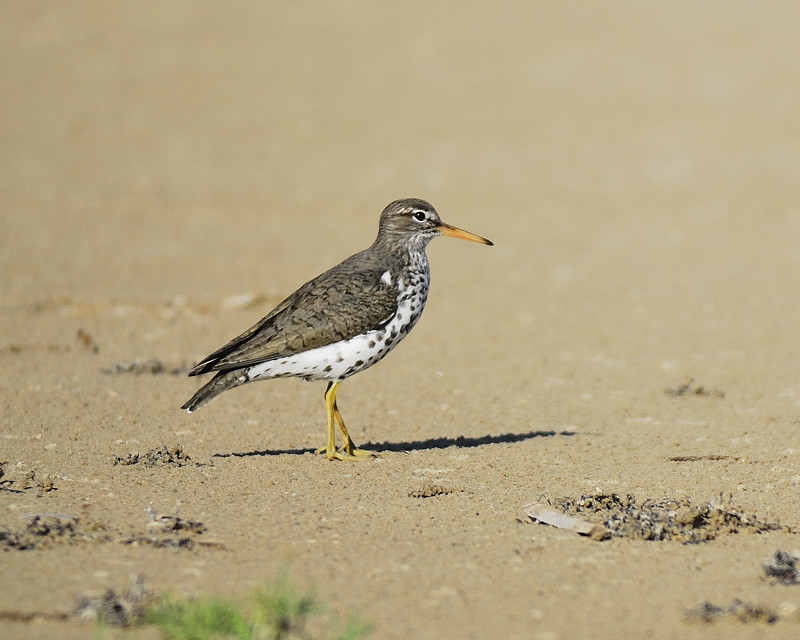
Spotted sandpiper, Actitis macularius (synonym, Actitis macularia; protonym, Tringa macularia), also known as the spotted tattler or as the teeter-tail, photographed at Sabine Woods Bird Sanctuary, near Sabine Pass, Texas.
Image: Joseph Kennedy, 4 May 2011 (with permission) [velociraptorize].
Nikon D200, Kowa 883 telescope with TSN-PZ camera eyepiece 1/1250s f/8.0 at 1000.0mm iso400
Question: Females of this North American mystery bird species are feminists; why do I say that? Can you tell me what peculiar behaviour this bird is known for? Can you identify this species?
Response: This is an adult spotted sandpiper, Actitis macularius, a species that is widespread throughout North America, and they also occasionally pop up in western Europe, too. This species breeds along mostly any water source -- rivers, lakes, ponds, etc. -- throughout the northern portions of North America.
This ground-nesting shorebird is interesting because most populations are polyandrous: females have a slightly larger body size than males; they migrate to their breeding areas before the males to claim the best territories; they court males and produce a clutch of four eggs before leaving him to search for another male. Females may breed with up to four males in one season, each of which will raise a clutch. The female will often raise a final clutch herself, although if she cannot find a second, third or fourth male, she will help rear the chicks. Interestingly, fathers of the first clutches may actually be the father of chicks in subsequent males' clutches, too, probably due to sperm storage within the female's reproductive tract.
Although the chicks leave the nest as soon as the last egg hatches, and the fluffy youngsters feed themselves, their father broods and watches over them for as long as four weeks post-hatch.
Spotted sandpipers' "alternate lifestyle" is also reflected in their physiology: even though blood plasma concentrations of testosterone and dihydrotestosterone ("activated testosterone") are substantially higher in males than in females, these levels plummet 25-fold in males once incubation is initiated. Additionally, mated females have testosterone concentrations that are 7 times higher than those of unmated females. [p. 115; An Introduction to Behavioral Endocrinology, Third Edition; Amazon UK; Amazon US].
Here is an exceptionally lovely video of a father spotted sandpiper with his first chick. Note that his newly-hatched chick, which can barely walk, already shows the species' famous "teeter-tail" behaviour:
The function of the teetering behaviour is not known. When you watch these birds, you will note that teetering is faster when the bird is nervous, but stops when the bird is alarmed, aggressive, or courting.
You are invited to review all of the daily mystery birds by going to their dedicated graphic index page.
If you have bird images, video or mp3 files that you'd like to share with a large and (mostly) appreciative international audience here at The Guardian, feel free to contact me to learn more.
.
email: grrlscientist@gmail.com
twitter: @GrrlScientist
